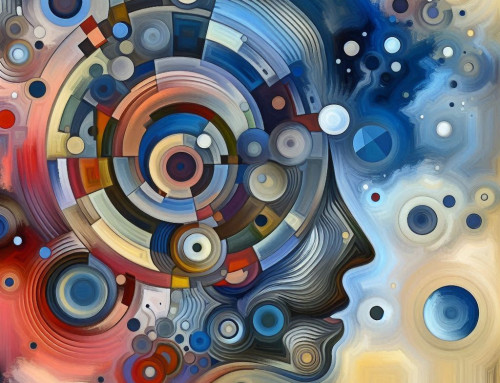Have you ever taken a personality test? The most common being the Myers Briggs personality test. Are you extroverted? Introverted? Judging, sensing, feeling? Do you ever make life choices based on that personality type you’ve been labeled as? Many do. Even if they don’t realize it. I’ve been told numerous times that a student can’t learn “this” way as they are more of a “that way” learner. Essentially claiming that they can’t learn a certain way.
Years ago, when I was teaching the Hapkido program at my instructor’s school back in Nebraska, I was teaching a gentleman that had to look at the written material sheet to remember his material. “Show me your bearhug defenses” I would ask. “Yes sir!” he replied, before pausing with a blank stare on his face. After a few seconds of nothing coming to mind, he would glance down at his material sheet on the floor next to him. Instantly he would be reminded of what to do.
He needed written information to remember his material early on when training. Makes sense, right? Except that he almost never read the sheet. He just needed to look at the sheet in general to recall the information. He trained himself to look at that sheet to remember his material. Eventually he would ingrain his material and not need the sheet. But early on, he had to have that sheet, just to look at to trigger his memory.
This student’s necessity to see a piece of paper before remembering anything stuck with me for years. I’ve been told all my life how everyone has a different learning style. Some need to visually see things demonstrated to learn. Some are more tactile and need to have an object in their hands to help them learn. Others need to read the information and so on and so forth. Due to this, as an instructor, I’ve tried my best to teach through as many different learning styles as possible to reach every student. But I had never heard of a learning style of needing to look at a piece of paper, while not reading it, to remember material. To me, it suggests that we can teach ourselves our learning styles.
In Junior high school, I was struggling with some of my grades. My father was quite confused as I would fail easy classes such as a basic English class while getting A’s in difficult classes like computer classes or Geometry. My father worked at the local college and scheduled me to get tested for learning disabilities. Upon taking the tests, I scored off the charts in a few categories. But I also tested so badly on other segments that my results couldn’t be charted. Hence why I either aced or flunked my classes. There was no middle ground.
Essentially, I was diagnosed with auditory processing disorder (a brain comprehension issue based on auditory input) and a reading disorder. How do most teachers present information to learn? Through reading and lectures. Two things I was told I couldn’t learn from. It was no surprise that I struggled in those classes. Because of this, I just blamed any bad grades on my learning disability and moved on. I wasn’t really given any options to fix the issues or get around them. I was given a paragraph to explain the disability and to “try” focusing harder. Other options to help me with these learning disabilities were too expensive.
Due to this, I never read any books in school. When I was forced to read assigned books, I struggled massively. It took me reading a single page numerous times over to understand what was written. If the book was made into a movie, I would rent the movie and write the essay based on the movie. Needless to say, I never passed any of these assignments. Fast forward years later, I’m reading book after book, attending seminars/lectures and endlessly listening to educational podcasts to learn information on martial arts, science, history and other things I’m interested in or need to learn. It kind of hit me one day. What changed? Did I wake up and the learning disabilities disappear? Definitely not.
Enter martial arts training. I’ve written about nearly every angle of which martial arts can help people achieve a higher quality of life and unlock their human potential. This issue was really no different for me. Effort is really the only attribute needed to learn martial arts and be good at it. But that doesn’t mean everyone can achieve success easily just by training. I’ve had numerous students quit over the years just because they believed their learning style was holding them back from learning martial arts.
“My ADHD won’t allow me to stay focused enough to learn” or “My learning style is tactile, which is why I never listen during the lecture portion” or “I can’t train outside of class as I can’t learn through reading the material sheets.” I’ve heard it all. This is where these personality types and learning styles interject themselves and may blow up a person’s journey of learning. Much of how we learn is learned behavior itself. This is why the student I mentioned at the onset of this blog post needed to look at a piece of paper to recall his material. He trained himself to do it that way.
He needed a trigger to recall his material. And since he began by reading his material, he was accustomed to looking at his material sheet to recall everything. Eventually, not needing to actually read, just look at it to trigger the memory. I truly believe we can improve our learning skills if we want to. My own experience has shown this to be true. I’m not an expert in diagnosing or “curing” learning disabilities by any stretch of the imagination. My own experience is anecdotal but very convincing to me that we can out train these characteristics to a degree. Willpower and the desire to change, improve, or learn something can be extremely powerful.
For students that struggle to learn from lectures and auditory explanations, I find these students also struggle a bit with visualizing as they missed key components to understand what a technique is used for. I struggled with this early on in my martial arts training. I consistently missed critical information that was taught orally. It’s difficult to simply “listen better”. Especially for people like me who struggle with a condition that makes hearing very difficult in certain situations. Over the years I’ve learned techniques and even devices that have helped.
Some things that have helped me are being able to see the person talking without obstruction. Seeing facial expressions and lips moving and gestures really helps fill in gaps that my hearing may not pick up. Adjusting hearing aids or using specific kind of ear plugs can help in some situations and for some people. But these have downsides as well. One on one in loud places and just listening, those have helped me. But conversations or trying to hear multiple people is still a struggle. The biggest help for me is something I learned from martial arts training. We present information in a direct way and with a specific end goal in mind. Then follow that up with physical examples before letting the student do a guided, slow attempt at what we are working on.
This has helped me ask better questions outside of martial arts training. To give you an example, I’ve recently went back to work as a structural steel CAD drafter (using a computer program to draw steel buildings that are to be built). This was what I went to college for and the field I worked in for a number of years before going full time with my martial arts studio. Some stuff was like riding a bike. But a lot of stuff was forgotten or was new. My boss explained how to do something first. I picked up a few details but not enough to understand.
I would follow up that information by repeating back to him what he told me but in my own way to confirm what he told me. If that was correct, I then asked for an example to visually see the results. Lastly, I attempted to recreate what was done while he guided me through mistakes and errors. I also took notes that made sense to me. If I forgot something, those notes were a great reminder. It may take an extra step or two when learning, but it saves numerous steps later when I would inevitably forget and have to ask him to repeat himself weeks/months later.
When it comes to reading, each rank in the martial arts systems I teach have material sheets that a student can reference and read through to help jog their memory. Some students thrive with these sheets, others never even glance at them. The upside to these sheets is that a student can train and remember material when not in class thanks to these sheets. The downside is that there can always be a missed translation or even a mistake in the written literature. Overall, these can be quite useful if the student has already learned the proper technique.
Beyond these sheets, that are mostly just notes and shorthand, are books I recommend to students as well as these blog posts. There is an incredible amount of information out there if one takes the time to sit down and read. While being interviewed on a podcast several years ago to promote my first book, the podcaster asked me, “Why a book? Why not a YouTube video or video series as more people watch those instead of reading?” He was correct in stating that most people these days seek out videos for information rather than reading.
Unfortunately, people miss so much information in a video. There is a tradeoff. You get visuals, but you lose details in information. There’s a reason why every time a movie is made from a book, everyone proclaims the book is better. The movie would need to be ten times longer to get the same detail and nuances that the book holds. Movies and videos were meant to be the condensed version for those who don’t have the time and just want visuals and a quick story. Nothing is wrong with that. But if you want detail, you need to read it or be taught it directly. As an instructor, I do my best to give clear details about what I’m teaching. However, I can’t spend an entire class lecturing about a technique or idea. I have to keep class moving. This is where I suggest students read up on it themselves for more in-depth clarity.
The issue here is that ability to read well, understand what has been read, and have the time to do so. For many people, that may feel impossible. It did for me in my youth. Overcoming a reading disability is one of my biggest success stories though. And figuring it out on my own was a process. I’ll do my best to explain how I went about things for myself, but there’s no guarantee that it will work for everyone. And it’s not lost on me that to get this information, one would have to be decent at reading! This is for those who are currently fighting to figure it out and for those who have friends and family that may need help.
First and foremost, I realized that when the information I was reading or listening to was something I was interested in, I tried much harder to learn. One big key to my success was discovering that when I knew the end result of what I was reading or listening to, I could follow the important stuff while not worrying about the fluff. It kept my focus on what I was trying to learn without veering off on less important information.
This was the key to me learning through any avenue. I just need the end result first. Meaning, if I know the conclusion, I can follow the path there. Think of putting a model car together. Most can simply follow the step-by-step instructions and get to the completed car. I struggle with that. Unless I can see what it will look like in the end, I’ll make every mistake possible on every step. But simply seeing the end result organizes my brain so that each step makes logical sense.
This may sound like it spoils the ending and ruins the book or podcast or even movie. But for me personally, the process was the important part. The ending was just a goal to shoot for, so I know I’ve succeeded in what I was doing. Such as obtaining a black belt. I loved all aspects of training and really wanted that black belt. And then I got it. And instantly I didn’t care about said black belt anymore. I was focused on what was next so I could begin the next journey. I’ll be discussing this more in a future blog post, so I’ll bookmark this for now.
While it wasn’t easy getting to this point, I’ve become quite good at learning through reading and lectures now. I know what questions to ask and what I need to focus on to get the information I desire. Aside from my own experience in overcoming these learning disabilities and the student I mentioned at the onset of this blog, another former student of mine really opened my eyes when it comes to these disabilities, personality types and other boxes we are forced into.
Nearly every youth student I enroll these days is labelled as ADD or ADHD. I’ve taught hundreds of youth students over the years, but I’ve only had one student who I felt truly suffered from this condition and even medication wasn’t working. A great kid by everyone’s standard. Very kind, generous, and smart. But staying focused was clearly a fight for him. Constant fidgeting and eyes darting in a new location with every tick of the clock. One day, however, I noticed something out of the ordinary for him. He was completely calm and focused for nearly 30 minutes. His eyes only darted when the front door chime rang when a random person entered or when I addressed the group.
We weren’t in class though. The students were working on homework in the study room. He didn’t have homework that day though. I was curious as to what captured his attention so greatly. He was drawing and coloring. And it was a fantastic drawing with clear talent and learned skill. Not just for his age, which was about eight. But even for an adult. This was the only time I had ever seen him so calm and focused. I recognized that focus, clarity, dedication and pure enjoyment beaming from him. I recognized it as it was the same look and feeling I have when I’m learning something new in martial arts or teaching. He had found his “thing”, just as I found my “thing” in martial arts, and specifically teaching.
This was an “ah hah” moment for me. He was controlling his ADHD in the same way I controlled my reading and auditory issues. Subconsciously at first, then by choice later. For me, as I suspect for him, the brain constantly fights what we are currently doing, constantly pulling us elsewhere…toward our “thing”. I still find myself sitting down to work on a project, only to be extremely antsy and unfocused. I then listen to my urges. Where is my brain trying to pull me? Then, if possible, I follow that urge. Complete that task, then go back to my project with full focus.
This blog post was such a thing. I’ve been fighting myself from writing on this subject for numerous reasons. Attempting to write something else every time I sat down to write. But I was unable to finish any of the other topics. I have about twenty other topics started with some writing on them. But every time I started on one of them, I distracted myself. And my mind went to this blog topic. I finally gave in. And now, I’m deleting fifty percent of what I wrote to condense the amount of writing I needed to get out on this subject. And in doing so, I made notes that will help me write about those other topics with ease. It’s as if my brain knew I needed to write this in order to proceed.
That student who was so focused on drawing? The class we had right after he drew that beautiful picture was his best class. As if he got the ADHD out and could finally focus on class. That continued the rest of the year for him while in my program. Let him draw when he wanted to draw, then let him continue class. It was a dramatic difference in his focus. He proceeded to even go up in rank. I wish I could tell you he is one of my black belts now, but he’s not. He didn’t return to the program the following year. Martial arts just wasn’t his “thing”. And that’s ok. He still accomplished something from it by getting a rank. Hopefully he came away with an understanding of how to, even if mildly, control his ADHD.
And this gets to the final point of this blog post. As an instructor, I hear and see the same issues from students that I’ve had over the years. And I hear the same excuses. From “my child has ADD/ADHD and that’s why their behavior is bad”, to “oh I can only learn through reading, which is why I never pay attention to your demonstration or lecture and just have you print off the material sheet to learn from”, and even “I’m introverted, so I can’t do the formal rank testing’s where everyone is watching, can you test me privately?”.
I’m sorry to be the bearer of bad news, but your personality tests, learning types, and the results of your five-minute online IQ test, are not exactly scientific and could be holding you back from improving yourself. But don’t worry, you’re a Libra and are pretty easy going and accepting of life altering changes…of course I’m lying, your astrology signs can hold you back as well.
Humans are not black and white. We are all shades of grey. We can’t compartmentalize our personalities or learning styles so easily. That’s not to say some people aren’t shy/introverted or that others are more extraverted. But this tends to be situational and can change over time or can be dependent on the environment you’re in. Maybe a person is a homebody who loves reading fantasy or loves a good movie/tv show. It’s easy to claim that introverted title. But place that person in a group of like-minded individuals who are discussing this person’s favorite book or movie and watch them light up with conversation and maybe even own the room like an extrovert.
One area that I discuss in my self-defense seminars is the personality types that are most likely to be attacked versus those who are rarely threatened. Those who portray shy, meek, head down, apologetic characteristics are the most likely to be victimized because predators assume this person will not fight back and may not report the incident. Whereas those who portray extremely confident types that have no problem going out of their way to tell you what you did wrong and own the room are rarely threatened. These people are assumed to be someone that would fight back and create massive issues for the predator. The word “portray” is an important word that I’ve used intentionally in the sentences above.
What I explain to people in these classes and seminars is that you can learn to change the way you portray yourself in these scenarios. Actively teaching yourself to look people in the eyes, keeping your chin level and posture strong, not apologizing for being you and walking with intent can give a perception of confidence. The nice thing about this is that consistent practice in this can actually improve confidence and the way you interact with others.
If we can work to overcome our learning disabilities, and we can change the way we are portrayed in situations, and introverts can become extroverts in specific situations, then why do we continue to confine ourselves in these boxes that hold us back from things we may desire? On a conscious level, it’s a convenient excuse to get out of doing something we don’t want to do. Beyond that though, I generally find it’s a fear of doing something out of our comfort zone or a lack of confidence in that specific scenario.
We should always be honest with ourselves and why we cling to identities that we do. It may seem to provide an identity and provide reasoning as to why we are who we are. But more times than not it simply creates boundaries and exclusion from things we may really want or need. These personality types, learning styles and astrology signs can be helpful and/or entertaining as long as we don’t encapsulate our entire lives around these identities. People have the ability to grow and change, no matter the age. We’d be amazed at what we can do and how we can change if we step out of the boxes we were placed in, or put ourselves in. Put simply, you are you, and I am me. The rest can get sorted out and reshuffled as we move along.







I like it. Putting people or things in boxes gives the appearance of understanding but it’s really a sign of ignorance. By classifying someone or something as belonging as a certain kind, eliminates the need for critical judgment. But in truth, it it means we don’t understand anything.
Exactly!